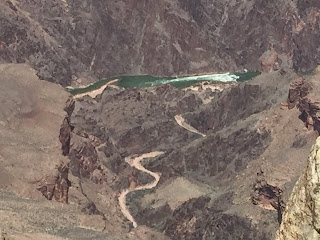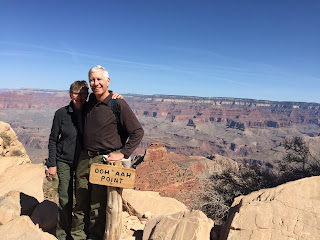On return to Las Vegas we got to spend one night at the home of our friends, the Orabka's. We have known them since our kids were small, and got together almost annually for many years. More recently, retirement took them to Las Vegas, where two of their three children live within blocks of them. It was fun to renew the friendship, however briefly.
The flight back to Kansas City was uneventful, and the weather at that end was far better than it had been when we started out. We spent one night there to touch base with the grandchildren one more time.
The next day we were off to Lincoln, Nebraska where we planned to spend a night with an old college buddy and his wife. From Lincoln we drove north to Fremont and the campus of Midland College (now Midland University), our alma mater, where we celebrated the 90th anniversary of the founding of the Midland Choir. Our greatly-respected and well-loved choral director from the 1970s was present (though nearly deaf in his mid-90s), as were a number of friends from college days.
Our plan had been to return to Fremont and the reunion on Saturday, but a winter storm (yes, in April) was moving in from the west with the threat of ice and snow. We left Lincoln mid-morning and escaped eastward to Des Moines, unfortunately skipping the rest of the festivities.
Time in Des Moines was spent helping my parents prepare for a transition from their home into a retirement community. There is significant accumulation of "stuff" that must be sorted, and much of it disposed with, in order to move from a three bedroom house to a one bedroom apartment. Sentimental attachments make the work painstaking.
Monday morning we were on the way homeward, anxious to meet our newest grandchild. She couldn't wait to be born after our return, but we got to see her at one week old. Because she came early, she is tiny. Her cousin, born two months earlier, started out well over 9 pounds. This little girl began just over 6 pounds. The difference is startling! But she is a big eater, and will undoubtedly catch up with him at some point.
After a couple days to rest and take care of various details (like our taxes), I will be heading back to Des Moines to continue helping my parents with their move. But there are no adventures on the horizon -- for a month or two.
The flight back to Kansas City was uneventful, and the weather at that end was far better than it had been when we started out. We spent one night there to touch base with the grandchildren one more time.
The next day we were off to Lincoln, Nebraska where we planned to spend a night with an old college buddy and his wife. From Lincoln we drove north to Fremont and the campus of Midland College (now Midland University), our alma mater, where we celebrated the 90th anniversary of the founding of the Midland Choir. Our greatly-respected and well-loved choral director from the 1970s was present (though nearly deaf in his mid-90s), as were a number of friends from college days.
Our plan had been to return to Fremont and the reunion on Saturday, but a winter storm (yes, in April) was moving in from the west with the threat of ice and snow. We left Lincoln mid-morning and escaped eastward to Des Moines, unfortunately skipping the rest of the festivities.
Time in Des Moines was spent helping my parents prepare for a transition from their home into a retirement community. There is significant accumulation of "stuff" that must be sorted, and much of it disposed with, in order to move from a three bedroom house to a one bedroom apartment. Sentimental attachments make the work painstaking.
Monday morning we were on the way homeward, anxious to meet our newest grandchild. She couldn't wait to be born after our return, but we got to see her at one week old. Because she came early, she is tiny. Her cousin, born two months earlier, started out well over 9 pounds. This little girl began just over 6 pounds. The difference is startling! But she is a big eater, and will undoubtedly catch up with him at some point.
After a couple days to rest and take care of various details (like our taxes), I will be heading back to Des Moines to continue helping my parents with their move. But there are no adventures on the horizon -- for a month or two.



















































